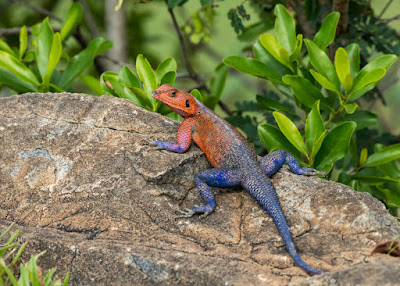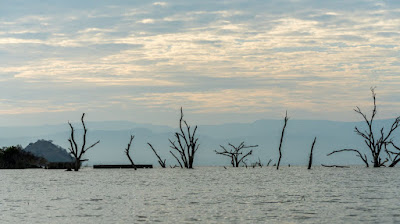 |
| Idaho Potato Museum, Blackfoot, Idaho. Many visitors want their photo taken with the big baked potato. |
If you happen to be driving around Idaho, consider visiting the Idaho Potato Museum in the town of Blackfoot, the Potato Capital of the World, on Interstate 15. I spent an hour there enjoying a wealth of information about the humble, yet glorious potato, and admiring the quality of the displays.
 |
| Left: 1930s McCormick potato cultivator; Middle: 1930s Oilver one-row pick planter to be pulled by two horses; Right: 1900s sulkey plow to be pulled by two horses. |
The museum is located in a former train depot, an old building next to railroad tracks. Even before entering, I got to see a number of antique agricultural implements displayed outdoor. Developed by potato growers, the earliest ones were pulled by up to four horses.
 |
| 1930s Pugh one-row potato harvester to be pulled by two horses. |
Besides the fact that I love rust for its look, hints of stories past, and photo opportunities, I had fun visualizing how the contraptions might work. The harvester in the above photo, when pulled forward, would drive the shovel-like front end into the soil, digging up potatoes. As they “climbed” onto the shovel, potatoes dug-up later would push potatoes dug-up earlier toward the back, off the shovel, up a conveyor belt of metal rungs gently sloping up. The bumping and bouncing would perhaps shake dirt off the potatoes. At the top of the conveyor belt, the potatoes would tumble into a larger receptacle.
 |
| The potato originated in the Andes in South America, where the Inca potato footplow or chakitailla, was used long before the 15th century and is still in use today. |
The museum is small but stuffed with historical, scientific and commercial info. The potato originated in the Andes in South America where native peoples cultivated it around 200 BC. In the 1500s, Spanish conquistadors seeking gold reached Peru. They brought home a treasure: the potato. In the 1600s, it spread through Europe, Africa, China, India, and Russia, and from Ireland to Bermuda, then Virginia. The first recorded potato planting in North America was in Nova Scotia, on the Atlantic coast of Canada, in 1623.
 |
| Four horses pull a three-row potato planter designed and built by a grower, around 1935. |
Today potatoes are grown in all 50 U.S. states. Idaho offers ideal potato growing conditions: a light volcanic ash soil, aquifer water for irrigation, hot days and cool nights in the summer, and a network of railroads to take potatoes to markets.
 |
| Left side: Colorado potato beetle stamps, postcards, and postmarks to educate the public about this pest. Right side: Stamps featuring a potato merchant (top left) or potatoes. |
 |
| Irish stamp commemorating the Irish Potato Famine of 1845-1850. |
Of some 125 potato-growing countries around the world, the five top producers are China, India, Russia, Ukraine, and the United States. The potato changed the world and made it to Mars, at least in the movie, “The Martian.”
 |
| Half of the museum's collection of stove-top potato bakers. |
 |
| One third of the museum's collection of sour cream dishes. |
The museum exhibits include a collection of collections (potato peelers, stove-top bakers, sour cream ceramic dishes, what may well be the largest collection of potato mashers in the world, postage stamps, toys, vintage posters of science activities for children…) and record-setting potato items (such as the largest potato chip ever made, a Pringle listed in the Guinness Book of World Records, and a bronze sculpture replica of the largest potato ever grown in Idaho).
The gift shop sells lots of potato-themed T-shirts, souvenirs (potato peelers), and food items (potato soup or pancake mixes, seasonings). The café serves baked potatoes best ordered hours in advance so they’re ready when you are. It’s a few dollars more for access to the toppings bar, or for the topping of the day for fearless gourmets. For smaller appetites, the menu includes French fries, potato cupcakes and potato ice-cream.
I didn’t eat at the café, but visiting the Idaho Potato Museum inspired me to reminisce about yummy potato dishes I tasted in my travels (such as plokkfiskur in Iceland, a fish and potato casserole) and plan to make them at home (any day now).
All text and photos, copyright Caroline Arnold. www.theintrepidtourist.blogspot.com




















